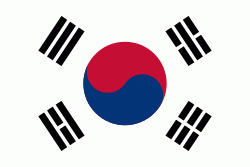Hongcheon County (Hongch’ŏn)
 |
Hongcheon's historic name was BulRyeokChunHyeon during the rule of Goguryeo. King Gyeongduk of Silla changed the name to YoungHyeon of Sak-Ju, In 1043, it was named Hongcheon during the reign of King In-Jong. Following the independence of the country on 15 August 1945, many administrative changes were made, affecting the jurisdiction of various units under its control.
Korean Federation for Environmental Movement (KFEM) opened an educational facility in Hongcheon in 1995.
Hongcheon County uses an emblem to represent itself as the “County of Culture and Tourism.” The emblem, a simple depiction of a leaf and dew, symbolizes a clean environment, patriotism, and love of one's hometown.
Map - Hongcheon County (Hongch’ŏn)
Map
Country - South_Korea
 |
 |
| Flag of South Korea | |
The Korean Peninsula was inhabited as early as the Lower Paleolithic period. Its first kingdom was noted in Chinese records in the early 7th century BCE. Following the unification of the Three Kingdoms of Korea into Silla and Balhae in the late 7th century, Korea was ruled by the Goryeo dynasty (918–1392) and the Joseon dynasty (1392–1897). The succeeding Korean Empire (1897–1910) was annexed in 1910 into the Empire of Japan. Japanese rule ended following Japan's surrender in World War II, after which Korea was divided into two zones; a northern zone occupied by the Soviet Union and a southern zone occupied by the United States. After negotiations on reunification failed, the southern zone became the Republic of Korea in August 1948 while the northern zone became the communist Democratic People's Republic of Korea the following month.
Currency / Language
| ISO | Currency | Symbol | Significant figures |
|---|---|---|---|
| KRW | South Korean won | â‚© | 0 |
| ISO | Language |
|---|---|
| EN | English language |
| KO | Korean language |















